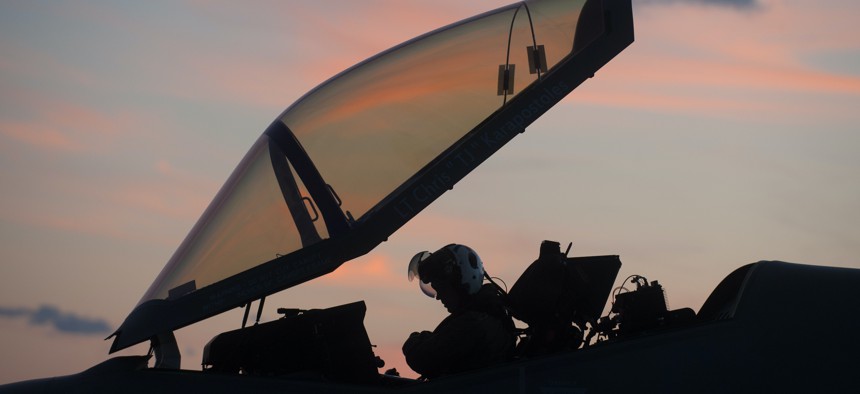
An F-35 test pilot prepares to commence night operations aboard USS Dwight D. Eisenhower, Oct. 8, 2015. U.S. Navy courtesy Lockheed Martin / Andrew McMurtrie
Lockheed Expects Revenue Decline Amid F-35 Cuts, Afghanistan Pullout
CEO Jim Taiclet also said the company's purchase of Aerojet Rocketdyne is delayed.
The end of the war in Afghanistan, supply-chain problems, flat defense spending, and lower F-35 purchases are leading Lockheed Martin to project lower revenue in 2022, company executives told investors Tuesday.
Lockheed projects $66 billion in sales next year, down from the $67 billion it expects to ink this year. If the projections hold up, it would mark the first year since 2013 that the company did not increase its sales.
“Our current expectation is that sales in 2022 will decline slightly from our expected 2021 sales,” CEO Jim Taiclet said on the company’s quarterly earnings call with investment analysts. “We then anticipate sales will increase slightly in 2023 with steadily increasing sales growth through 2026.”
Lockheed’s stock fell more than 12 percent in mid-afternoon trading.
Taiclet also said the company’s planned acquisition of Aerojet Rocketdyne would be delayed until the first quarter of 2022. It was supposed to close by year’s end, but federal regulators have been giving the deal extra scrutiny.
The CEO also said that the mergers-and-acquisition “window isn't that open right now,” in part because of increased regulatory scrutiny by the Biden administration.
Taiclet, however, doubled down in his initiative to focus the company on the Pentagon’s push to network and link every weapon on the battlefield. He was bullish on the company’s hypersonic weapons and several classified initiatives expected to move from development to production between 2023 and 2026.
Lockheed is competing to build new helicopters for the Army and a new refueling tanker for the Air Force. The company is expected to increase production of the Marine Corps CH-53K helicopter and F-35, although annual production of the fighter is no longer expected to be as high as previously planned.
The F-35 cuts equate to about a $400 million reduction in F-35 revenue next year, acting CFO John Mollard said on the call.
Like many U.S. companies across all sectors, Lockheed has experienced supply-chain problems that have delayed projects. Mollard said the issues have been worse with commercial-aerospace suppliers who have been hard hit by the COVID-19 pandemic and its drop in passenger air travel.
“If we're looking at parts of the supply chain that are strictly defense, they're probably not nearly as stressed financially as our dual-use suppliers,” Mollard said.
Lockheed said it will continue paying its subcontractors more money up front through 2022, a practice that executives have said saved some smaller suppliers from going out of business during the pandemic. It is expected to advance $1.5 billion to its suppliers in 2022, Mollard said.
The withdrawal of all U.S. forces from Afghanistan and collapse of the Afghan military will cost the company about $200 million per year, Mollard said.
“The primary impact to us is in the contract special ops logistics support program,” Mollard said.
Earlier Tuesday, Raytheon CEO Greg Hayes said the Afghanistan withdrawal would cost the company about $75 million.
The company’s 2022 projections do not factor in a possible $24 billion increase in U.S. defense spending proposed by three of four Democrat-led Pentagon oversight panels. The Senate Appropriations Defense subcommittee last week recommended adding $1.7 billion for 16 Lockheed-made C-130J cargo plans.
The company also blamed the loss of a U.K. nuclear weapons contract for contributing to its losses.
Taiclet also said the company would increase buys of its own stock—a practice Sen. Elizabeth Warren, D-Mass, has called “paper manipulation.” The company has repurchased $2 billion shares over the first three quarters of 2021, Taiclet said.
“With our stock trading at a level well below what we calculate is the company's intrinsic value, we have significantly increased our planed share buybacks, and I anticipate that we will repurchase up to $6 billion of our shares over the next 12 [to] 18 months if conditions warrant,” he said.
